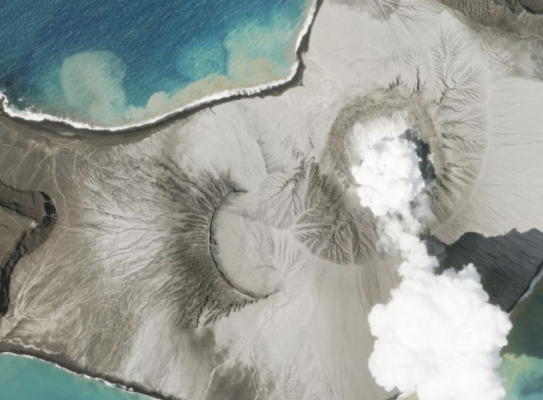New research challenges current assumptions of Hunga (Tonga) eruption trigger

A newly published study in the international Journal of Volcanology and Geothermal Research offers an alternative mechanism that triggered the 15 January 2022 Hunga (Tonga) eruption, proposing the powerful eruption was caused by a gas-driven climactic explosion rather than a phreatomagmatic one - where magma and water react violently through the water column.
The paper(external link), led by the Australian National University in collaboration with GNS Science, presents a new evidence-based model that describes how the formation of a gas seal led to the amassing and release of enough explosive energy within minutes to form a 58 km high ash plume, a crater deeper than the Burj Khalifa Tower (Dubai) is high and atmospheric shock waves that promulgated the entire planet.
The authors Richard Henley, Richard Arculus, Thanh-Son Pham, Ana Casas (ANU), Cornel de Ronde (GNS), Graham Hughes (Imperial College), Vasily Titov and Sharon Walker (NOAA) contend a gas-driven trigger is probable based on the eruption magnitude, the time sequence of the event, the mass amounts of volcanic gas release, the remaining volcano structure and the presence of minerals formed through magmatic gas interactions with the surrounding rock (e.g. sulphate minerals).
What we witnessed during this event was a Plinean eruption. These are the kind most people think of when imagining an erupting volcano – very intense, violent and sudden with extremely high ash columns.
For a submarine volcano to release enough energy through the water column to create this immense plume as well as a globally-felt atmospheric air blast would take a colossal amount of force, similar or even larger than that of the 1883 Krakatoa eruption.
“Our model describes a process that explains how the accumulation of volcanic gases over the months leading up to the eruption could generate this scale of explosive energy,” said Henley.

The paper hypothesises the eruption sequence as follows:
a fluctuation of magma-derived reactive gases aggressively alters the rocks in the volcano core ➔ this reaction creates a seal that blocks gas flow to the surface ➔ the internal gas pressure increases and puts stress on the volcanic structure ➔ the seal fractures, leading to an explosive release of compressed gas ➔ the crater enlarges and the deepening enables run-away gas explosion through releasing higher and higher pressure gas from the porous rock mass ➔ the eruption declines as the compressed gas depletes and seawater backfills the crater.
The proposed model is further supported by numerical modelling that calculates the potential energy of the trapped compressed gas matches independent observations of the scale of the eruption.
“Not only does the paper suggest that the Hunga Plinean eruption was gas-driven but proposes that this mechanism may be characteristic of all Plinean eruptions regardless of whether the volcano is oceanic or subaerial. If correct, a pause in gas discharge may act as a precursor of a large eruption event,” said Henley.
The eruption at Hunga has opened our eyes.
“Understanding the cause of the eruption is important for volcano monitoring and risk preparedness, not just for the Tongan archipelago but for the numerous submarine volcanoes that sit within New Zealand’s maritime estate,” said GNS co-author de Ronde.
To further investigate the evidence supporting Henley et al.’s theory and other potential warning signs of an upcoming eruption, GNS Science will lead an international marine voyage from 14 May to 12 June to Hunga Volcano to collect geological, geophysical and water column data inside the crater and over the flanks of the submerged eruption vent.